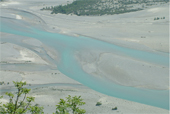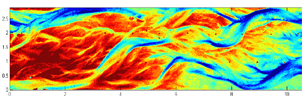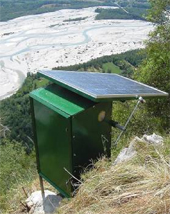Dr Walter Bertoldi, MSc and PhD (Trento University) in Environmental Engineering
Visiting Research Fellow
Email: w.bertoldi@qmul.ac.uk
Research
Research Interests:
My research focuses on braided river geomorphology, with a particular interest in understanding linkages between water, sediments and vegetation. In my post-doctoral research activity I focussed the attention on the identification of spatial and temporal scales that control braided rivers evolution, analysing and modelling sediment transport processes, bar formation and river bifurcation. My research is mainly based on laboratory modelling and field investigation, but from my engineering background I am also familiar with mathematical and numerical modelling of fluvial processes.
I am presently working on the project “BIOGEOMORPHOLOGY OF RIPARIAN SYSTEMS: SPACE, TIME AND NEW INFORMATION SOURCES” founded by The Leverhulme Trust.

Ten years vegetation evolution in a reach of the Tagliamento River, Italy
Overall objective of this research project is a large-area investigation of the consequences of two-way interactions between river processes and riparian trees in different environmental settings. We will employ an innovative combination of biogeomorphological theory, ground measurements and remote sensing. We will develop methods to extract information from airborne LiDAR and CASI data that can separate riparian woodland from underlying landforms and can identify key biogeomorphic properties of each to advance functional understanding of river corridor dynamics across large areas.
This research will be developed using data for the River Tagliamento, Italy, a morphologically intact system where river flows, sediment transport and riparian trees interact across a range of climatic and hydrological conditions in an essentially unmanaged setting.

An example of the LiDAR data
The research is relevant and applicable to several areas of river management practice. Understanding of the complex biogeomorphic functioning of riparian trees under changing environmental conditions is crucial to (a) predicting likely changes in river systems under environmental, particularly climate, change; (b) developing cost-effective, environmentally sensitive river channel management strategies, and (c) designing sustainable river restoration approaches that benefit from vegetated landforms emerging through ‘natural’ fluvial biogeomorphic successions.
I have also recently worked on:
RIVER BIFURCATION MORPHOLOGY (PhD and post-doctoral research at University of Trento, Italy)

A bifurcation in the River Tagliamento
Aim of the research is the understanding of fluvial bifurcations that are a crucial process in forming and controlling braided networks.
Investigation has been carried out through mathematical analysis, experimental modelling and field observations. Result is the quantification of the discharge distribution in the distributaries and the related bed and bank evolution. A strong asymmetry of the configuration has been observed, controlled by the width to depth ratio and the sediment mobility. The role of migrating alternate sediment bars has been also studied, pointing out the intrinsic instability and the fast temporal evolution of gravel-bed unconstrained rivers.
Work is in progress to assess the suitability of different 1D and 2D numerical models.
SEDIMENT TRANSPORT IN GRAVEL-BED BRAIDED RIVERS (post-doctoral research at University of Trento and University of Western Ontario, Canada)

DEM of a flume braided network
Bed-load transport evaluation in braided rivers is still an unresolved task, due to the highly dynamic behaviour of these systems, which evolve on multiple spatial and temporal scales. Flume data and filed measurements have been used to investigate main parameters and controls, as well as to test simple mathematical models.
Daily repeated surveys on a proglacial river (Sunwapta, Canada) and direct flume measurements of bed-load flux (on a large laboratory facility 3x25 m, University of Trento) demonstrated the different behaviour of multi-channel systems compared to single-thread channels. In particular, the active width (part of the river instantaneously experiencing sediment movement) has been identified to play a crucial role.
INUNDATION DYNAMICS AND MORPHOLOGY OF THE RIVER TAGLIAMENTO (post-doctoral research at University of Trento)

The effect of floods characterised by increasing magnitude has been also investigated on the River Tagliamento, focussing the attention on the planform configuration and evolution in relation to the net bed changes and the flood intensity. We developed an automated image acquisition system in order to survey the river evolution at an hourly temporal scale. We chose two 1 km long reaches (a bar-braided and an island-braided reach) where we installed two automated digital cameras on the surrounding cliffs. The two cameras (reflex digital cameras 6 MPixel resolution, 18 mm lens) are controlled by a Linux embedded board and by software that manages image acquisition and download. The power is guaranteed by a solar photovoltaic panel and two batteries, that ensure a 4-cloudy-days endurance. Pictures are taken every hour during daylight, but acquisition interval can be chosen by the user. The main strength of this monitoring setup is the temporal resolution that allow the investigation of dynamic processes and their relationship to water discharge. Inundation dynamics have been studied in detail, considering the peculiar expansion-contraction dynamics typical of braided patterns.
Research on the River Tagliamento is presently carried out in collaboration with University of Trento (M. Tubino), IGB Berlin (K. Tockner) and University of Padova (N. Surian)